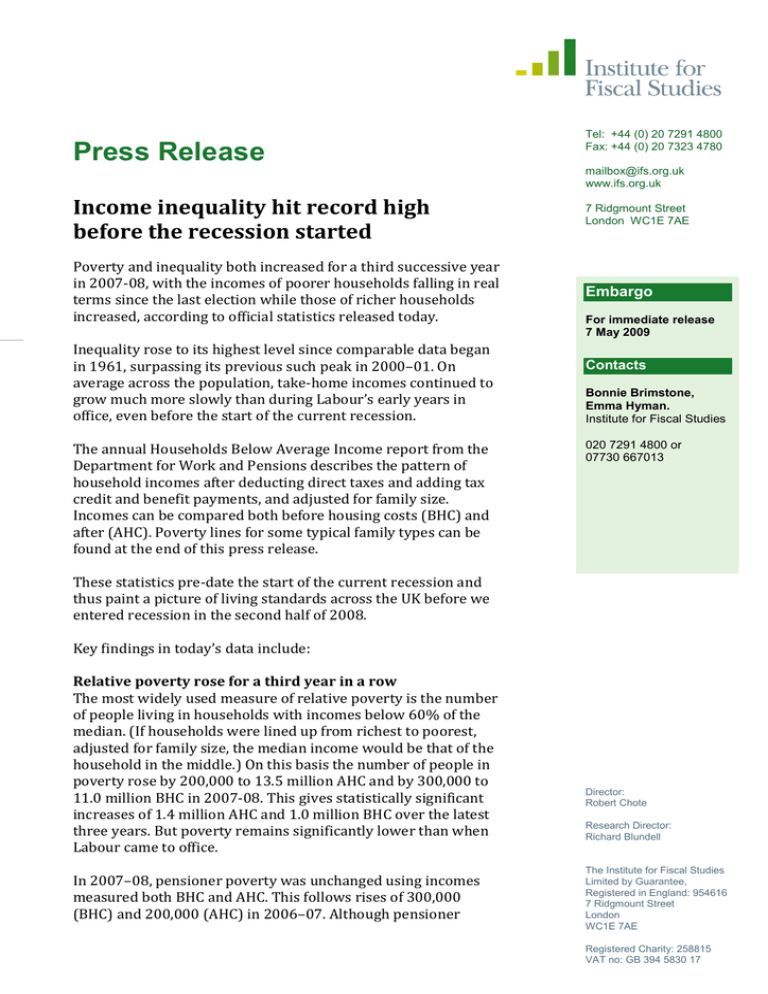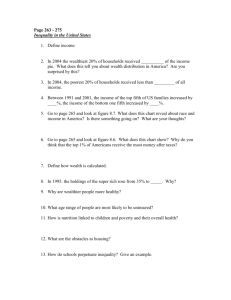Press Release Income inequality hit record high
advertisement

Press Release Tel: +44 (0) 20 7291 4800 Fax: +44 (0) 20 7323 4780 mailbox@ifs.org.uk www.ifs.org.uk Income inequality hit record high before the recession started 7 Ridgmount Street London WC1E 7AE Poverty and inequality both increased for a third successive year in 2007-08, with the incomes of poorer households falling in real terms since the last election while those of richer households increased, according to official statistics released today. Embargo Inequality rose to its highest level since comparable data began in 1961, surpassing its previous such peak in 2000–01. On average across the population, take-home incomes continued to grow much more slowly than during Labour’s early years in office, even before the start of the current recession. The annual Households Below Average Income report from the Department for Work and Pensions describes the pattern of household incomes after deducting direct taxes and adding tax credit and benefit payments, and adjusted for family size. Incomes can be compared both before housing costs (BHC) and after (AHC). Poverty lines for some typical family types can be found at the end of this press release. For immediate release 7 May 2009 Contacts Bonnie Brimstone, Emma Hyman. Institute for Fiscal Studies 020 7291 4800 or 07730 667013 These statistics pre-date the start of the current recession and thus paint a picture of living standards across the UK before we entered recession in the second half of 2008. Key findings in today’s data include: Relative poverty rose for a third year in a row The most widely used measure of relative poverty is the number of people living in households with incomes below 60% of the median. (If households were lined up from richest to poorest, adjusted for family size, the median income would be that of the household in the middle.) On this basis the number of people in poverty rose by 200,000 to 13.5 million AHC and by 300,000 to 11.0 million BHC in 2007-08. This gives statistically significant increases of 1.4 million AHC and 1.0 million BHC over the latest three years. But poverty remains significantly lower than when Labour came to office. In 2007–08, pensioner poverty was unchanged using incomes measured both BHC and AHC. This follows rises of 300,000 (BHC) and 200,000 (AHC) in 2006–07. Although pensioner Director: Robert Chote Research Director: Richard Blundell The Institute for Fiscal Studies Limited by Guarantee, Registered in England: 954616 7 Ridgmount Street London WC1E 7AE Registered Charity: 258815 VAT no: GB 394 5830 17 poverty is still statistically significantly higher than its recent low in 2005–06, it remains considerably lower than in 1998–99. Poverty amongst working-age adults without dependent children is now at its highest level since the start of our comparable series in 1961, which stood at 14% (BHC) and 18% (AHC) in the latest year of data. This group has not been the focus of tax and benefit reforms to date under the current government. Government highly unlikely to meet child poverty target Having risen in the two previous years, child poverty (BHC) remained constant at 2.9 million in 2007-08, but is now 200,000 higher than its recent low point in 2004-05. Measured AHC, child poverty increased by 100,000 in 2007-08 to reach 4.0 million, up from its recent low point of 3.6 million in 2004-05. The Government has a target to halve child poverty BHC from its level in 1998-99 by 2010-11. Having cut child poverty by about 60,000 per year over the last nine years, it now needs to cut it by 400,000 a year over the next three to meet the target. Indeed, the Government has still not managed to lower child poverty by a quarter from its 1998-99 level: having risen since 2004-05, it is now only 16% lower than in 1998-99 (BHC). Before last month’s Budget, IFS research estimated that, on current plans, child poverty would have fallen by around a third between 1998–99 and 2010–11, thereby falling short of its target by 600,000. We estimated that additional spending of £4.2 billion a year would be required to expect to meet it. Given that Budget 2009 allocated less than £0.2 billion towards meeting the target, most of this gap still remains. Given the state of the public finances, it seems unlikely that the government will find the remaining £4 billion needed in the 2009 Pre-Budget Report. Average incomes grew slowly even before the recession. Median income hardly grew at all in 2007-08, whilst mean incomes grew by a little over 1%. These are similar rates to those seen over the previous five years, but well below the 2% or more a year recorded in Labour’s first five years in office. This underlines the fact that the increases in poverty seen during 2007-08 reflect weak income growth towards the bottom of the income distribution rather than rapid income growth in the middle. It is also noteworthy that take-home incomes were barely increasing at all, even before the recession took hold later in 2008. This was also a time of real-terms falls in average earnings. Accelerating levels of inflation also eroded the real value of state benefits and tax credits. The Institute for Fiscal Studies Limited by Guarantee, Registered in England: 954616 7 Ridgmount Street London WC1E 7AE Income inequality reaches a record high. The Gini Coefficient – a commonly used measure of income inequality – increased to 0.36 in 2007-08, the highest level seen over our consistent time series going back to 1961. This follows increases in inequality in the previous two years. Over the period since 2004-05, the incomes of the poorest fifth of households have fallen by 2.6%, after inflation, whilst the incomes of the richest fifth rose by nearly 3.3% on the same basis. “Since the election, average incomes across the population have grown slowly, whilst they have fallen for the poorest. The recession may see poorer households regain some ground if benefits grow more rapidly than the wages, salaries and bonuses of the better off. But if history is any guide, average income growth is likely to slow even further across the population.” says Alastair Muriel, IFS Research Economist. ENDS Notes to Editors: 1. The full Households Below Average Income publication can be found on the Department for Work and Pensions website at (http://www.dwp.gov.uk/asd/hbai.asp) 2. Further analysis of the data underlying the official statistics will available in Poverty and Inequality in Britain: 2009 by Mike Brewer, Alastair Muriel, David Phillips and Luke Sibieta. This report will be launched at IFS on 8 May 2009. The briefing will start at 10:30am and is expected to conclude by 12:30pm. If you would like to attend, please contact Bonnie Brimstone (020 7291 4800 or bonnie_b@ifs.org.uk). 3. An accompanying briefing note, “Living standards during previous recessions,” analyses what happened to measures of living standards, poverty and inequality during previous recessions. 4. The official HBAI document reports numbers in poverty to the nearest 100,000, but reports changes in poverty based on the unpublished unrounded numbers. Where no official estimate exists of the change in poverty between two years, this note reports the change in the rounded numbers. Growth rates reported in this press release are calculated based on rounded figures. 5. The authors are very grateful for financial support from the Nuffield Foundation for the project „Poverty and Inequality: 2007–2009‟. Co-funding from the ESRC-funded Centre for the Microeconomic Analysis of Public Policy at IFS is also very gratefully acknowledged. Poverty lines (60% of median household equivalised income) in 2007-08 include: £ per week Childless Single Couple, Couple, couple individual one child two children (age 8) (ages 8 & 15) Lone parent, one child (age 8) Lone parent, two children (ages 8 & 15) AHC £199 £115 £239 £322 £155 £239 BHC £236 £158 £283 £361 £206 £283 The Institute for Fiscal Studies Limited by Guarantee, Registered in England: 954616 7 Ridgmount Street London WC1E 7AE






